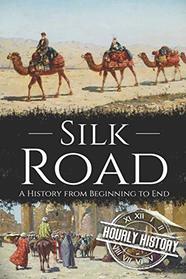Silk was the most coveted product (90% of the trade between China and Rome) imported by the Romans by 50 BCE. Egyptians and Greeks also coveted rare silk fabrics. The Silk Road was the scene of much trading. The items moving west were gunpowder, silks, spices, paper, tea, medicines, porcelain, and ivory. The Chinese wanted horses, slaves, glassware, woolen items, dogs, weapons, grapes, and grapevines.
Byzantium Emperor Justinian wasn't willing to continue to pay the high price for silks and he sent 2 monks to China to find out how to duplicate the process. He was successful and the Byzantium kingdom kept the process secret and it became a valuable product for 1000 years.
The Silk Road was never one road but was an interconnected web of trails. The whole trip was over 5000 miles, including traveling over 1000 miles of desert. Traders tended to take their goods over a portion of the trail to another trading center, sell their goods, and another trader takes it further along the route to another center. By the 10th century, the Silk Road was the most important thoroughfare in the world.
This intermingling of different peoples and tribes caused a cross-pollination of religions, philosophies, and cultures. Marco Polo is discussed in this book. An interesting tidbit was about Christopher Columbus. In his travels to the New World, he had a well-marked volume of Marco Polo's wildly popular book.
What finally killed the Silk Road (or made it less cost-effective) were the advances in maritime construction and navigation. Another factor was the Qing Dynasty's decision to make China more isolationist. As land travel became more costly and dangerous, maritime travel and trade took its place. This is an interesting, and concise, overview of the most important avenue of trade between the East, the Middle East, and Europe before modern times.
Byzantium Emperor Justinian wasn't willing to continue to pay the high price for silks and he sent 2 monks to China to find out how to duplicate the process. He was successful and the Byzantium kingdom kept the process secret and it became a valuable product for 1000 years.
The Silk Road was never one road but was an interconnected web of trails. The whole trip was over 5000 miles, including traveling over 1000 miles of desert. Traders tended to take their goods over a portion of the trail to another trading center, sell their goods, and another trader takes it further along the route to another center. By the 10th century, the Silk Road was the most important thoroughfare in the world.
This intermingling of different peoples and tribes caused a cross-pollination of religions, philosophies, and cultures. Marco Polo is discussed in this book. An interesting tidbit was about Christopher Columbus. In his travels to the New World, he had a well-marked volume of Marco Polo's wildly popular book.
What finally killed the Silk Road (or made it less cost-effective) were the advances in maritime construction and navigation. Another factor was the Qing Dynasty's decision to make China more isolationist. As land travel became more costly and dangerous, maritime travel and trade took its place. This is an interesting, and concise, overview of the most important avenue of trade between the East, the Middle East, and Europe before modern times.




